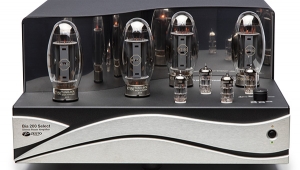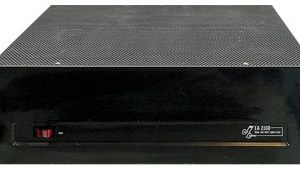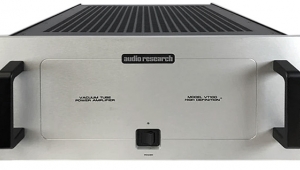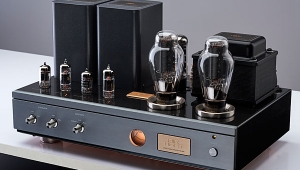| Columns Retired Columns & Blogs |
Conrad-Johnson Premier Twelve monoblock amplifier
Conrad-Johnson is one of audio's "marquee" companies, and charges accordingly. The Premier Twelve tube monoblock power amplifier, rated at 140W, sells for a rather steep $3495 each, meaning that unless you listen in mono, be prepared to lay out almost $7000 just for the amplification link in your audio chain. Apparently, many audiophiles feel the money is well spent: according to Conrad-Johnson, the Twelve has been a consistently strong seller during its approximately five-year production history.
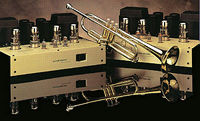 What do you get for your $7000, aside from 140Wpc and a top-shelf name? Physically, you get a pair of graceful, low-slung amplifiers that combine open architecture with a removable protective tube cage. Cosmetically, you get the clean, brushed-brass-and-black C-J "look."
What do you get for your $7000, aside from 140Wpc and a top-shelf name? Physically, you get a pair of graceful, low-slung amplifiers that combine open architecture with a removable protective tube cage. Cosmetically, you get the clean, brushed-brass-and-black C-J "look."
The circuitry is relatively straightforward: a triode amplifier input stage using two halves of a 5751 twin-triode tube in parallel, direct-coupled to a pair of cathode-coupled phase splitters (6FQ7s) outputting a balanced, low-impedance signal to two pairs of push-pull 6550s (new old stock GEs). The output tubes are coupled to a large output transformer (custom-engineered and built to Conrad-Johnson's specs) said to feature high phase linearity and wide bandwidth. A 12dB negative-feedback loop is used to lower distortion and raise the damping factor so the amplifier can better handle reactive loads.
In other words, nothing too exotic or retro is going on. The key to the Premier Twelve's success must be more in the execution than in the design. The power supply includes separate DC regulation for the input and phase-inverter stages (which C-J claims prevents them from being "back-modulated" by the output stage), and four large, custom-made polypropylene capacitors (in parallel with polystyrene) in place of the usual electrolytics. Parts quality on the two boards—one for the power supply, the other for the audio—is high, including Vishay resistors and custom-made polystyrene capacitors in the audio circuit. There are no electrolytic capacitors in the audio circuit or its related power supplies.
Connection is via a machined set of gold-plated five-way binding posts and a gold-plated RCA jack. You won't be playing with exotic power cords with the C-J Twelve: the power transformer is hardwired to an anonymous black cord made by Electri Cord of Westfield, Pennsylvania. You'll save thousands right there! C-J's position is that a direct, soldered connection between the power transformer and power cord provides a sonic benefit, while preventing the end user from playing with non-UL-approved and potentially dangerous cords.
The Twelve comes with the output transformer wired for 4 ohm use, but dealer-selectable taps for 2, 8, and 16 ohm operation are also provided. Setting and maintaining the output tube bias is particularly easy: using the supplied screwdriver, you turn a pot (there one for each tube) clockwise until an LED lights. Then you back it off until the LED goes dark again. You're done. There's also a factory adjustment for minimizing distortion when changing the 6FQ7s.
During the many months I had the Premier Twelves, no tubes went down, nor did I experience any problems whatsoever with the amplifiers. If you're hesitant to buy a tube amp because of "tube hassles," for whatever it's worth to you, in over a dozen years of running tube amps...I've had none!
Popularity Plus
It doesn't take long to hear why the Premier Twelve remains popular, and why so many audiophiles continue to be willing to spend $7k on a pair when more powerful, less expensive alternatives abound.
If designing and "voicing" an amp is a high-wire act, the Premier Twelve crossed the Grand Canyon barely breaking a sweat. The overall sound, driving either the Audio Physic Virgos or the Sonus Faber Concerto Grand Pianos, was finely detailed yet rich, open, and transparent, with a lush, mesmerizing midband; deep, well-developed, yet punchy bass; and high frequencies that were fast and sparkly but never bright or aggressive.
The difficult transitions between the frequency extremes and the midrange were carefully accomplished, though the upper midrange exhibited a rich, golden bloom—a sonic bouquet—too subtle to be called a coloration but sufficiently pronounced to enrich brass, strings, female voices, alto sax, and hall ambience with an intoxicating glow.
Tube amps usually excel at licking those harmonic envelopes and sounding "fleshed out" in the upper mids and highs, but they often fail to portray transients with the requisite edge and speed to sound convincing, especially on pop and rock. The Premier Twelve sounded "fast" and rhythmically taut throughout the musical bandwidth—and with all kinds of music. It was the "snappiest," most coherent performance from a lush-sounding tube amp I've heard in my system.
- Log in or register to post comments
